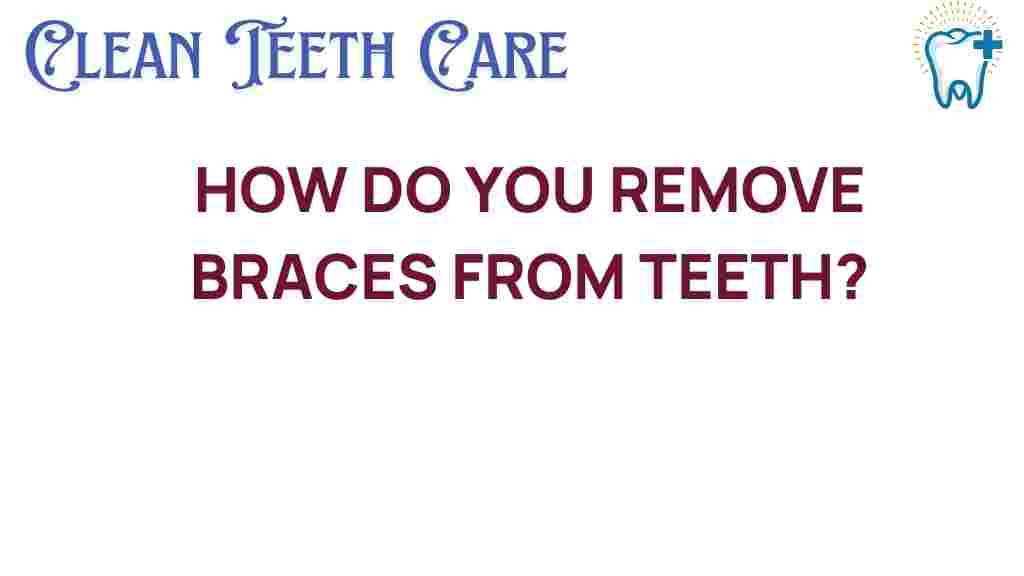The Art of Braces Removal: What to Expect and How It’s Done
Braces removal is a significant milestone in the journey of orthodontics. After months or even years of wearing braces, many patients eagerly anticipate the day their brackets and wires are taken off. This article will guide you through the braces removal process, what to expect, and how to care for your teeth after the removal. We’ll also discuss the importance of dental care and oral hygiene during this transitional phase, ensuring you understand the patient experience fully.
Understanding Braces Removal
Braces are used in orthodontics to correct misaligned teeth and jaws. Once your orthodontist determines that your teeth have straightened sufficiently, you will be scheduled for braces removal. This procedure is generally straightforward and quick, but understanding the steps involved can help ease any anxiety you may have.
What to Expect Before Braces Removal
Before the big day, your orthodontist will conduct an evaluation to ensure your teeth are ready for removal. This evaluation may include:
- A final check-up of your teeth alignment.
- Taking photographs or X-rays to document your progress.
- Discussing your post-removal care and any follow-up treatments needed.
It’s essential to maintain good oral hygiene leading up to your braces removal appointment. Brush and floss diligently to prevent any issues that might delay the process.
The Step-by-Step Process of Braces Removal
The actual removal of braces is a relatively simple procedure that often takes about 30 to 60 minutes. Here’s what you can expect during the appointment:
- Preparation: You’ll be seated in the dental chair, and your orthodontist will prepare the necessary tools.
- Removal of Archwire: The first step involves removing the archwire that connects all the brackets. This is usually done with a special tool that gently loosens the wire.
- Removal of Brackets: Next, the orthodontist will carefully remove each bracket from your teeth. They use a special instrument to gently pop the brackets off, ensuring minimal discomfort.
- Cleaning Your Teeth: Once the brackets are removed, your orthodontist will clean any residual adhesive from your teeth. This is often done with a dental polisher, leaving your teeth smooth and clean.
- Final Evaluation: After everything is removed, your orthodontist will check your teeth to ensure everything looks perfect.
- Fitting Retainers: Finally, your orthodontist will discuss the importance of retainers and fit you with one if necessary. Retainers help maintain the new position of your teeth.
The entire process is usually pain-free, but you might experience some pressure or slight discomfort as the brackets are removed. If you have any concerns, communicate them with your orthodontist, who can provide reassurance and assistance.
Post-Removal Care: Maintaining Your Dental Health
After your braces removal, the way you care for your teeth is crucial. Here are some essential tips to maintain your dental health:
- Follow Oral Hygiene Practices: Continue brushing twice a day and flossing daily. After braces removal, your teeth will feel different, but it’s vital to keep them clean.
- Use Fluoride Toothpaste: This helps in strengthening your enamel and keeping your teeth healthy.
- Avoid Hard Foods: For the first few days after removal, avoid hard or crunchy foods that may irritate your gums.
- Stay Hydrated: Drink plenty of water to help wash away food particles and keep your mouth fresh.
- Wear Your Retainer: Wearing your retainer as prescribed is critical to prevent your teeth from shifting back to their original positions.
Troubleshooting Tips After Braces Removal
While the braces removal process is generally straightforward, some patients may experience a few issues afterward. Here are some common concerns and tips on how to address them:
- Sensitivity: It’s normal for your teeth to feel sensitive after braces removal. Use a toothpaste designed for sensitive teeth and avoid extremely hot or cold beverages.
- Retainer Discomfort: If your retainer feels uncomfortable or causes pain, consult your orthodontist. They may need to adjust it for a better fit.
- Gum Irritation: If you experience gum irritation, rinse your mouth with warm salt water to soothe any inflammation.
- Teeth Feeling Uneven: It’s common for your teeth to feel slightly uneven after removal. However, if this sensation persists, contact your orthodontist.
Enhancing Your Patient Experience
The patient experience during braces removal can be greatly improved by understanding the process and preparing yourself mentally. Here are some tips to enhance your experience:
- Ask Questions: Don’t hesitate to ask your orthodontist about the removal process and what to expect afterward.
- Bring a Friend: Having a supportive friend or family member accompany you can help ease any anxiety.
- Plan a Celebration: Consider treating yourself to something special after your appointment to celebrate your new smile!
By preparing yourself and maintaining open communication with your orthodontist, you can ensure a positive experience during your braces removal.
Conclusion
Braces removal is an exciting and pivotal moment in your orthodontic journey. By understanding what to expect and how to care for your teeth afterward, you can ensure a smooth transition to your new smile. Remember to prioritize your oral hygiene and follow your orthodontist’s instructions closely, especially regarding post-removal care and retainer usage. With the right care and attention, you’ll enjoy the benefits of your beautiful, straight teeth for years to come.
For more information on maintaining your dental health after braces removal, visit this resource. If you have any questions or need guidance on your orthodontic journey, feel free to consult your orthodontist.
With the right knowledge and care, you can make the most of your braces removal and enjoy a lifetime of confidence in your smile!
This article is in the category Treatments and created by CleanTeethCare Team
